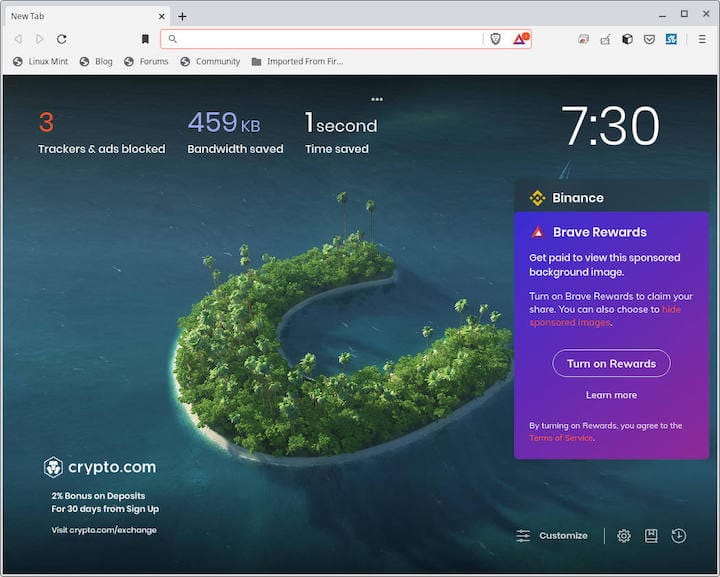How To Install Brave Browser on AlmaLinux 10

In this tutorial, we will show you how to install Brave Browser on AlmaLinux 10. Brave Browser has emerged as a leading privacy-focused web browser that prioritizes user security while delivering exceptional performance. Built on the Chromium foundation, Brave offers native ad-blocking, tracker protection, and cryptocurrency integration features that make it increasingly popular among Linux users. AlmaLinux 10, as the next iteration in the Red Hat Enterprise Linux ecosystem, will continue to provide enterprise-grade stability and security for organizations and individual users alike.
This comprehensive guide walks you through multiple installation methods for Brave Browser on AlmaLinux 10, ensuring you can choose the approach that best fits your system requirements and security preferences. Whether you’re a system administrator managing multiple installations or an individual user seeking enhanced web browsing privacy, this tutorial provides detailed instructions, troubleshooting tips, and best practices for a successful installation.
Understanding Brave Browser and Its Benefits
What Makes Brave Browser Unique
Brave Browser distinguishes itself through its privacy-first architecture that blocks advertisements and trackers by default. Unlike traditional browsers that require extensions for privacy protection, Brave integrates these features natively, resulting in faster page loading times and reduced bandwidth consumption. The browser’s Chromium foundation ensures compatibility with existing Chrome extensions while maintaining superior privacy standards.
The built-in Brave Rewards system allows users to earn Basic Attention Tokens (BAT) by viewing privacy-respecting advertisements, creating a unique ecosystem that compensates users for their attention. This innovative approach to web browsing aligns with growing concerns about data privacy and user compensation in the digital advertising landscape.
System Requirements and Compatibility
Brave Browser supports 64-bit AMD/Intel (amd64/x86_64) and ARM (arm64/aarch64) architectures, making it compatible with modern AlmaLinux 10 installations. The browser requires minimal system resources, typically consuming less memory than traditional browsers due to its efficient ad-blocking mechanisms. A minimum of 4GB RAM and 200MB of available disk space ensures optimal performance, though these requirements may vary based on usage patterns and installed extensions.
Prerequisites and System Preparation
Verifying System Requirements
Before installing Brave Browser, verify your AlmaLinux 10 system meets the necessary requirements. Check your system architecture using the following command:
uname -mEnsure your system has sufficient disk space and memory:
df -h /
free -hUpdate your package database to ensure you have the latest package information:
sudo dnf updateInstalling Required Dependencies
Install the essential packages needed for repository management and secure package installation:
sudo dnf install dnf-plugins-core curl gnupg2These packages provide the necessary tools for adding third-party repositories and verifying package signatures, ensuring a secure installation process.
Security and Permission Considerations
Ensure you have sudo privileges for installation commands. Running installation commands as root is not recommended for security reasons. Instead, use sudo to execute commands with elevated privileges only when necessary. Verify your user’s sudo access:
sudo -lInstallation Methods Overview
Available Installation Approaches
AlmaLinux 10 users can choose from several installation methods, each with distinct advantages. The official repository method provides the most secure and maintainable installation, ensuring automatic updates through the system’s package manager. The one-command installation script offers convenience but requires careful security consideration. Alternative methods like Snap packages provide sandboxed environments but may have performance implications.
Recommended Installation Method
For AlmaLinux 10 systems, the official repository installation method is strongly recommended. This approach ensures proper integration with the system’s package management, automatic security updates, and optimal performance. The repository method also simplifies future maintenance and troubleshooting procedures.
Method 1: Official Repository Installation (Recommended)
Step 1: System Preparation and Updates
Begin by updating your AlmaLinux 10 system to ensure all packages are current:
sudo dnf update -yInstall the required repository management tools:
sudo dnf install dnf-plugins-core -yThis command installs the plugins necessary for adding and managing third-party repositories securely.
Step 2: Adding the Brave Repository
Add the official Brave Browser repository to your system. For AlmaLinux 10, which follows RHEL patterns, use the Rocky/RHEL repository configuration:
sudo dnf config-manager --add-repo https://brave-browser-rpm-release.s3.brave.com/brave-browser.repoThis command creates a new repository configuration file in /etc/yum.repos.d/ directory, enabling your system to download Brave Browser packages from the official source.
Step 3: GPG Key Import and Verification
Import the official Brave Browser GPG signing key to verify package authenticity:
sudo rpm --import https://brave-browser-rpm-release.s3.brave.com/brave-core.ascVerify the imported key fingerprint for additional security:
gpg --show-keys --with-fingerprint /etc/pki/rpm-gpg/RPM-GPG-KEY-brave-coreThis verification step ensures you’re installing genuine Brave Browser packages and protects against potential security threats.
Step 4: Installing Brave Browser
Install Brave Browser using the DNF package manager:
sudo dnf install brave-browser -yThe installation process will download the browser package and resolve any dependencies automatically. You may see additional packages being installed, such as graphics drivers and font packages, which are necessary for optimal browser functionality.
Step 5: Installation Verification
Verify the successful installation by checking the browser version:
brave-browser --versionTest the installation by launching the browser from the command line:
brave-browserThe browser should start successfully, indicating a proper installation.
Method 2: One-Command Installation Script
Quick Installation Process
Brave provides an official installation script for users who prefer a streamlined installation process. Execute the following command to download and run the installation script:
curl -fsS https://dl.brave.com/install.sh | shSecurity Verification for Script Installation
For enhanced security, verify the script’s signature before execution:
curl -fsSLO "https://dl.brave.com/install.sh{,.asc}"
gpg --keyserver hkps://keys.openpgp.org --recv-keys D16166072CACDF2C9429CBF11BF41E37D039F691
gpg --verify install.sh.ascOnly proceed with the installation if the signature verification succeeds. This method provides convenience but requires trust in the remote script execution process.
When to Use Script Installation
The script installation method is suitable for one-time installations or environments where repository management is not practical. However, this method may not provide automatic updates through the system package manager, requiring manual update procedures.
Method 3: Snap Package Installation (Alternative)
Installing Snapd on AlmaLinux 10
For users preferring containerized applications, Brave is available as a Snap package. First, install the EPEL repository and snapd:
sudo dnf install epel-release -y
sudo dnf install snapd -yEnable and start the snapd service:
sudo systemctl enable --now snapd.socketCreate the necessary symbolic link for classic snap support:
sudo ln -s /var/lib/snapd/snap /snapInstalling Brave via Snap
Install Brave Browser using the snap package manager:
sudo snap install braveConsiderations for Snap Installation
While Snap packages provide sandboxing benefits, they may have slightly higher resource usage and slower startup times compared to native packages. The official Brave documentation recommends using native repository packages when possible for optimal performance.
Post-Installation Configuration and Setup
Launching Brave Browser
After successful installation, launch Brave Browser using several methods:
Command Line:
brave-browserDesktop Environment:
Navigate to Activities → Show Applications → Brave Web Browser, or search for “Brave” in your application launcher.

Creating Desktop Shortcuts:
Most desktop environments automatically create application shortcuts during installation. If needed, manually create shortcuts using your desktop environment’s tools.
Initial Browser Configuration
When first launching Brave, you’ll encounter the setup wizard. Configure the following essential settings:
- Import Data: Transfer bookmarks, passwords, and settings from existing browsers during the initial setup process.
- Default Search Engine: Choose your preferred search engine from the available options or add custom search providers.
- Privacy Settings: Review and adjust Brave Shields settings, cookie handling preferences, and tracking protection levels.
Brave Shields Configuration
Configure Brave’s signature privacy features through the Shields panel:
- Ad and Tracker Blocking: Adjust blocking levels from standard to aggressive based on your privacy preferences and site compatibility needs.
- Cookie Management: Set cookie policies for enhanced privacy while maintaining site functionality.
- Script Blocking: Configure JavaScript blocking settings for maximum security, though this may affect site functionality.
Setting Brave as Default Browser
Configure Brave as your system’s default browser:
xdg-settings set default-web-browser brave-browser.desktopAlternatively, use your desktop environment’s settings panel to change the default browser through the graphical interface.
Browser Customization and Advanced Configuration
Account Setup and Synchronization
Create a Brave account to synchronize bookmarks, settings, and preferences across multiple devices. Navigate to Settings → Sync to establish an account and configure synchronization options.
- Brave Rewards Setup: Optionally enable Brave Rewards to earn BAT tokens through privacy-respecting advertisement viewing. This feature requires account creation and wallet setup.
- Extension Management: Install Chrome extensions through the Chrome Web Store, as Brave maintains compatibility with the Chrome extension ecosystem.
Performance Optimization
Optimize Brave Browser performance through advanced settings:
- Hardware Acceleration: Enable GPU acceleration for improved video playback and graphics rendering performance.
- Memory Management: Configure tab discarding and memory optimization settings for systems with limited resources.
- Cache Configuration: Adjust cache settings based on available disk space and performance requirements.
Updating Brave Browser
Automatic Updates via Package Manager
When installed through the official repository, Brave Browser receives automatic updates through the system package manager. Check for updates manually:
sudo dnf check-update brave-browser
sudo dnf update brave-browserInclude Brave in system-wide updates:
sudo dnf updateUpdate Verification and Monitoring
Monitor Brave updates by checking the browser version after updates:
brave-browser --versionSubscribe to Brave’s security announcements and release notes to stay informed about important updates and security patches.
Manual Update Procedures
For installations using the script method, manual updates may be necessary. Re-run the installation script to update to the latest version, or switch to the repository method for automatic updates.
Troubleshooting Common Installation Issues
Repository and Network Problems
Connection Timeouts: If repository access fails, check your network connectivity and DNS resolution:
ping brave-browser-rpm-release.s3.brave.com
nslookup brave-browser-rpm-release.s3.brave.comGPG Key Verification Failures: Re-import the GPG key if verification fails:
sudo rpm --import https://brave-browser-rpm-release.s3.brave.com/brave-core.ascPermission and Security Issues
SELinux Conflicts: If SELinux prevents browser execution, check for denials:
sudo ausearch -m avc -ts recent | grep braveAdjust SELinux policies as needed while maintaining system security.
Firewall Restrictions: Ensure your firewall allows outbound HTTPS connections for browser functionality and updates.
Runtime and Performance Issues
Graphics Problems: Install additional graphics drivers if you experience display issues:
sudo dnf install mesa-vulkan-drivers vulkan-loaderAudio/Video Playback: Install multimedia codecs for enhanced media support:
sudo dnf install mozilla-openh264Dependency Resolution
If dependency conflicts occur during installation, use DNF’s problem-solving capabilities:
sudo dnf install brave-browser --allowerasingThis command resolves conflicts by removing conflicting packages when necessary.
Security Considerations and Best Practices
Repository Security Management
Regularly verify repository integrity and update GPG keys when notified. Monitor security advisories from both Brave Software and the AlmaLinux security team for potential vulnerabilities.
- Repository Authentication: Ensure repository URLs use HTTPS and verify SSL certificates during package downloads.
- Package Verification: Always verify package signatures before installation, especially when using alternative installation methods.
Browser Security Configuration
- Privacy Settings Optimization: Configure Brave’s privacy settings to match your security requirements while maintaining usability.
- Extension Security: Only install extensions from trusted sources and regularly review installed extensions for security issues.
- Regular Security Audits: Periodically review browser settings, installed extensions, and stored data to maintain security posture.
System-Level Security Integration
- SELinux Configuration: Work with SELinux policies to maintain system security while allowing proper browser functionality.
- User Permission Management: Avoid running the browser with elevated privileges unless absolutely necessary for specific administrative tasks.
Uninstalling Brave Browser
Complete Removal Process
Remove Brave Browser using the package manager:
sudo dnf remove brave-browser -yRemove the repository configuration to prevent future package installations:
sudo rm /etc/yum.repos.d/brave-browser.repoUser Data Cleanup
Remove user configuration and cache directories:
rm -rf ~/.config/BraveSoftware
rm -rf ~/.cache/BraveSoftwareData Backup: Before removal, backup important bookmarks and settings if you plan to reinstall or migrate to another browser.
System Cleanup
Clean the package cache to free disk space:
sudo dnf clean allPerformance Optimization and Monitoring
System Resource Management
Monitor Brave’s resource usage using system tools:
top -p $(pgrep brave)Configure system resource limits if necessary for shared environments or resource-constrained systems.
Browser Performance Tuning
- Tab Management: Use Brave’s built-in tab management features to optimize memory usage with multiple open tabs.
- Cache Optimization: Adjust cache size based on available disk space and browsing patterns.
- Extension Impact Assessment: Regularly evaluate extension performance impact and remove unnecessary extensions.
Congratulations! You have successfully installed Brave. Thanks for using this tutorial for installing the Brave web browser on your AlmaLinux OS 10 system. For additional help or useful information, we recommend you check the official Brave website.